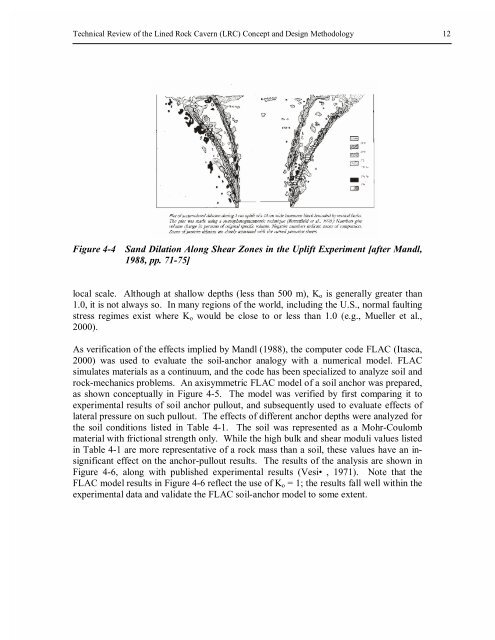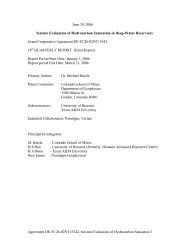Technical Review of the Lined Rock Cavern Concept and Design ...
Technical Review of the Lined Rock Cavern Concept and Design ...
Technical Review of the Lined Rock Cavern Concept and Design ...
Create successful ePaper yourself
Turn your PDF publications into a flip-book with our unique Google optimized e-Paper software.
<strong>Technical</strong> <strong>Review</strong> <strong>of</strong> <strong>the</strong> <strong>Lined</strong> <strong>Rock</strong> <strong>Cavern</strong> (LRC) <strong>Concept</strong> <strong>and</strong> <strong>Design</strong> Methodology 12<br />
Figure 4-4 S<strong>and</strong> Dilation Along Shear Zones in <strong>the</strong> Uplift Experiment [after M<strong>and</strong>l,<br />
1988, pp. 71-75]<br />
local scale. Although at shallow depths (less than 500 m), Ko is generally greater than<br />
1.0, it is not always so. In many regions <strong>of</strong> <strong>the</strong> world, including <strong>the</strong> U.S., normal faulting<br />
stress regimes exist where Ko would be close to or less than 1.0 (e.g., Mueller et al.,<br />
2000).<br />
As verification <strong>of</strong> <strong>the</strong> effects implied by M<strong>and</strong>l (1988), <strong>the</strong> computer code FLAC (Itasca,<br />
2000) was used to evaluate <strong>the</strong> soil-anchor analogy with a numerical model. FLAC<br />
simulates materials as a continuum, <strong>and</strong> <strong>the</strong> code has been specialized to analyze soil <strong>and</strong><br />
rock-mechanics problems. An axisymmetric FLAC model <strong>of</strong> a soil anchor was prepared,<br />
as shown conceptually in Figure 4-5. The model was verified by first comparing it to<br />
experimental results <strong>of</strong> soil anchor pullout, <strong>and</strong> subsequently used to evaluate effects <strong>of</strong><br />
lateral pressure on such pullout. The effects <strong>of</strong> different anchor depths were analyzed for<br />
<strong>the</strong> soil conditions listed in Table 4-1. The soil was represented as a Mohr-Coulomb<br />
material with frictional strength only. While <strong>the</strong> high bulk <strong>and</strong> shear moduli values listed<br />
in Table 4-1 are more representative <strong>of</strong> a rock mass than a soil, <strong>the</strong>se values have an insignificant<br />
effect on <strong>the</strong> anchor-pullout results. The results <strong>of</strong> <strong>the</strong> analysis are shown in<br />
Figure 4-6, along with published experimental results (Vesi , 1971). Note that <strong>the</strong><br />
FLAC model results in Figure 4-6 reflect <strong>the</strong> use <strong>of</strong> Ko = 1; <strong>the</strong> results fall well within <strong>the</strong><br />
experimental data <strong>and</strong> validate <strong>the</strong> FLAC soil-anchor model to some extent.

















